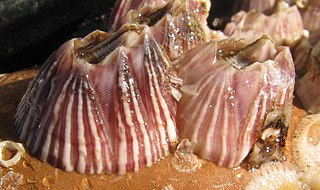
A barnacle is a type of arthropod constituting the subclass Cirripedia in the subphylum Crustacea, and is hence related to crabs and lobsters. Barnacles are exclusively marine, and tend to live in shallow and tidal waters, typically in erosive settings. They are sessile (nonmobile) and most are suspension feeders, but those in infraclass Rhizocephala are highly specialized parasites on crustaceans. They have four nektonic larval stages. Around 1,000 barnacle species are currently known. The name "Cirripedia" is Latin, meaning "curl-footed". The study of barnacles is called cirripedology.

Balanus is a genus of barnacles in the family Balanidae of the subphylum Crustacea.

The Chthamalidae are a family of chthamaloid barnacles, living entirely in intertidal/subtidal habitats, characterized by a primary shell wall of eight, six, or four plates, lacking imbricating plate whorls, and either membraneous or more rarely calcareous basis. They are not found below immediate subtidal habitats, and more likely are found in the highest tier of shallow-water barnacle fauna. They can be found in the most rigorous wave-washed locations, and some species are found in the surf zone above high tide mark, only receiving water from wave action at high tide.

Acorn barnacle and acorn shell are vernacular names for certain types of stalkless barnacles, generally excluding Pedunculata. As adults they are typically cone-shaped, symmetrical, and attached to rocks or other fixed objects in the ocean. Members of the barnacle order Balanomorpha are often called acorn barnacles.

Whale barnacles are species of acorn barnacle that belong to the family Coronulidae. They typically attach to baleen whales, and sometimes settle on toothed whales. The whale barnacles diverged from the turtle barnacles about three million years ago.

Megabalanus is a genus of barnacles in the family Balanidae. Members of the genus grow to 7 cm (2.8 in) in length and inhabit the lower intertidal zone.

Balanus nubilus, commonly called the giant acorn barnacle, is the world's largest barnacle, reaching a diameter of 15 cm (6 in) and a height of up to 30 cm (12 in), and containing the largest known muscle fibres.

Amphibalanus improvisus, the bay barnacle, is a species of acorn barnacle in the family Balanidae.

The tessellated blenny is a species of combtooth blenny found in the western Atlantic ocean.

Balanus balanus is a species of acorn barnacle in the Balanidae family. It is native to the colder seas of the northern hemisphere.

Balanus crenatus is a species of acorn barnacle in the Balanidae family. It is found in the North Pacific and the North Atlantic Ocean.

Amphibalanus amphitrite is a species of acorn barnacle in the Balanidae family. Its common names include the striped barnacle, the purple acorn barnacle and Amphitrite's rock barnacle. It is found in warm and temperate waters worldwide.

Balanus perforatus is a species of barnacle in the family Balanidae. It is found on the lower shore and in the neritic zone in the warm temperate parts of the eastern Atlantic Ocean.
Megabalanus stultus is a species of barnacle first described by Charles Darwin in 1854. It lives on fire corals of the genus Millepora in the Atlantic Ocean from Florida to southern Brazil.

Balanus trigonus is a species of barnacle in the family Balanidae. It is steep-sided, conical barnacle, has six shell plates and is pink in colour. They are opportunistic fouling organisms that are endemic to the Indo-Pacific region.

Amphibalanus eburneus, the ivory barnacle, is a species of acorn barnacle in the family Balanidae. It occurs on the east coast of North America, the Caribbean Sea and Gulf of Mexico.

Megabalanus coccopoma, the titan acorn barnacle, is a tropical species of barnacle first described by Charles Darwin in 1854. Its native range is the Pacific coasts of South and Central America but it is extending its range to other parts of the world.
Chamaesipho is a genus of four-plated notochthamaline barnacles in the Pacific Ocean limited to Australian/New Zealand temperate waters. They are intertidal in preference, and tend to form crowded columnar colonies. They can be identified in the field by having a four-plated wall, an unfused rostrum, and narrow opercular plates. Elminius, which also inhabits the same area, has four plates in its shell wall. However, in Elminius, the rostrum and rostrolatera are fused completely, and the compound rostrum receives the alae of the adjacent carinolaterals. In Chamaesipho, the unfused rostrum bears alae, and closely resembles the carina in appearance.

Megabalanus azoricus, the Azorean barnacle, is a species of large barnacle in the family Balanidae endemic to the Azores. It is the largest and third most common shallow water barnacle of the Azores, where it is heavily exploited for food and has a high comercial value since the colonization of the islands. It was included in the 100 species for priority management within Macaronesia. It is a thoracopodal filter feeder and the majority are hermaphrodites. It is more abundant in the first 3 m (9.8 ft) on the low intertidal and infralittoral rocky shores. The empty shells of the barnacles are a vital habitat for the blennies Parablennius ruber, P. incognitus and Coryphoblennius galerita as they provide shelter and substrata for egg deposition during reproduction. A large number of invertebrate species also use the empty shells. Although present throughout the archipelago, it is more abundant in the eastern islands. It has a genetic similarity with Megabalanus tintinnabulum. Some crucial features of the M. azoricus species are digonic hermaphroditism in sessile adults, development of planktotrophic larvae, dependence on exposed rocky shores in the intertidal habitat, and insular distribution restricted to the northeastern Atlantic oceanic islands.
















